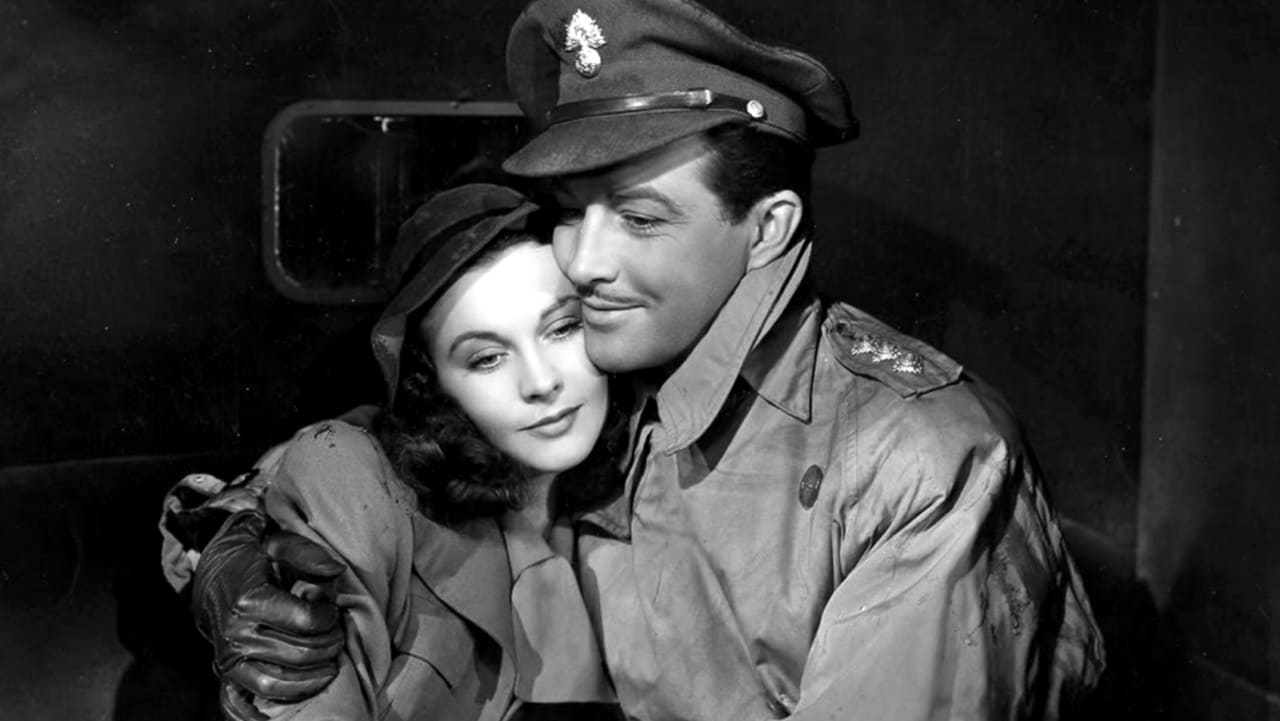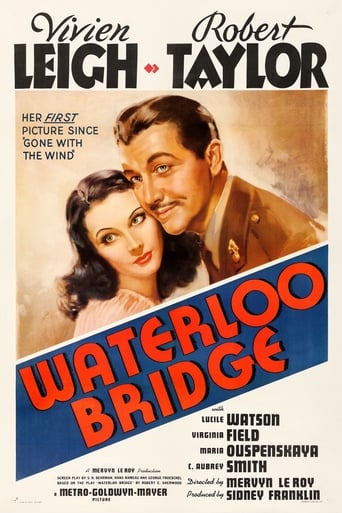



everything you have heard about this movie is true.
View MoreClever, believable, and super fun to watch. It totally has replay value.
View MoreI think this is a new genre that they're all sort of working their way through it and haven't got all the kinks worked out yet but it's a genre that works for me.
View MoreThe storyline feels a little thin and moth-eaten in parts but this sequel is plenty of fun.
View More... and I can hardly ever say that about precode films remade in the production code era.The original Waterloo Bridge starred Mae Clarke and was considered a pre-code, with more stark portrayal and language about the heroine's fate. Although this 1940 version was under the heavy hand of the censors, I still like it just as much as the original version. Basically we have a young woman who believes the man she loves is dead and has no way to survive but the world's oldest profession. It's not a fate she chooses, just one that she has to choose in order to eat. Yet society judges her although nobody gives her an alternative.Everyone remembers Vivien Leigh for "Gone with the Wind", but I think that this film and "That Hamilton Woman" are truly her best performances. The romance and chemistry between her and Robert Taylor is genuine, and just adds to the tragedy of the entire film, and then there's the final scene - which I can't tell you about without spoiling it for you. Just let me say that one piece of jewelry and one line spoken in remembrance makes the film complete.
View MoreI was bored tonight so looked and found this wonderful gem of a movie. The title actually is the catalyst for this drama. First we meet the star crossed lovers then we see the heroine fall from grace and at the end how the movie ends. The acting is superb and I would like to say when Miss Leigh is on the screen it crackles with life and energy and watch her eyes how she does not have to say a word as her eyes are her voice I find that is such a skill she has and in addition her eyes are mesmerizing. At the start we find her character young and full of love and happiness and then watch her fall into despair over a love she thinks she has lost but then when she finds out that her love is alive she cannot live with the shame that she brought upon herself. I was moved and this movie I could watch over and over just for Miss Leigh. Robert Taylor was good along with the fine character actors in the MGM casting. In many ways you could say that Vivien Leigh had a skill at playing the doomed heroine but she is so good and yes so gorgeous.
View More"Waterloo Bridge" started life as a stage-play; this is the second of three cinematic adaptations. (The others are a 1931 film, also called "Waterloo Bridge", and "Gaby" from 1956). The film opens on 3rd September 1939, the day World War II broke out. Roy Cronin, a senior officer in the British Army, is travelling to France to join his regiment. He briefly stops on Waterloo Bridge to reminisce about his experiences during the First World War, and the rest of the story is told in flashback. His memories, however, are not of the actual fighting but of his romance with a beautiful ballerina named Myra Lester whom he first met on the bridge. The two plan to marry, but are prevented from doing so by circumstances. Myra loses her job with the ballet company whose formidable director, Madame Olga Kirowa, objects to her relationship with Roy. (Her surname was presumably chosen to suggest an association with the famous Kirov Ballet, although the ballet did not acquire that name, that of an assassinated Soviet politician, until 1934). Believing- wrongly- that Roy has been killed in action, and unable to find alternative employment, Myra and her friend Kitty descend into prostitution to prevent themselves from starving.Yes, you heard right. Prostitution. And that in the heyday of the Production Code. I have never seen the 1931 version of this story, but understand that it dealt with the subject much more frankly and as a result was banned in America after the Code came into force. It is therefore surprising that MGM could get away with making a remake, although the subject is dealt with very cautiously. (As Dr Johnson said of a dog walking on its hind legs, it is not done well, but one is surprised to see it done at all). The dreaded p-word is never actually uttered, and the dubious nature of Myra and Kitty's method of earning a living is conveyed only by euphemism and innuendo. Nevertheless, the audience is left in no doubt that the two are what would have been called, in the language of the day, "fallen women".Which leads us to the film's greatest plot-hole. The screenwriters were doubtless influenced by memories of the "hungry thirties" when many women may well have faced the unenviable choice which confronts Myra and Kitty. As others have pointed out, however, economic conditions in 1917/18 were very different. Even if Myra and Kitty could not find work as dancers (and there must have been many West End shows catering for soldiers on leave), there were a great number of other jobs available to women, either in work directly related to the war effort (nursing, munitions), or in industries left desperately short of labour by the exodus of men to join the Forces. The film's central premise, therefore, just does not ring true. The "extended flashback" structure also struck me as a mistake because it means that the viewer is aware, from the very beginning of the film, that Roy survives the war and therefore knows that the report of his death must be erroneous. It might have made for greater emotional impact if we had been allowed to believe, with Myra, that Roy has died.The film's other main weakness is the miscasting of Robert Taylor as Roy. (Vivien Leigh would have preferred her husband Laurence Olivier as her leading man, but was overruled). When the film began I wondered why Roy had an American accent and two possibilities occurred to me, besides the obvious one that Taylor did not want to attempt a British one. The first was that Roy was a Canadian, the second that he was an American who had volunteered for the British Army before America's entry into the war and had subsequently acquired British nationality. Neither, however, turned out to be correct. It transpires that he is actually a member of an aristocratic Scottish family, and as such Taylor seems completely unconvincing. Had the script been rewritten to make him an American he might have been quite good.On the positive side, Leigh is heartbreakingly beautiful. (This was her first film after "Gone with the Wind"). The film was a box-office success when first released, and her popularity must have played a major part in this. Her role may have been badly written, but she plays it with great sincerity and enables the viewer to empathise with Myra. I would say that she is the best thing about the film, although there are also good contributions in smaller roles from Maria Ouspenskaya as Kirowa and C. Aubrey Smith as Roy's elderly uncle. Overall, however, "Waterloo Bridge" is a film which does not hold up well today, partly because this sort of sentimental melodrama has gone out of fashion, partly because of its own weaknesses in plot and casting. It is hard to understand why both Leigh and Taylor considered it a personal favourite; both acted in much better films than this. 5/10Some goofs. The church where Roy and Myra hope to marry appears as a vast Gothic cathedral from the outside and as a modest chapel in the Classical style from the inside. We learn that the badge of Roy's regiment (the fictitious Rendleshire Fusiliers) is a broken lance, but he wears a different badge on his cap, the flaming grenade of the Grenadier Guards. The style of his uniform looks more American than British, and other British soldiers, even in scenes set at the end of the war in 1918, are seen wearing the uniforms of 1914/15, with peaked caps rather than helmets. The list of officers killed in action is headed by a Gunner; the term "Gunner" in the British Army refers to a private solider in the artillery, not to an officer. And why are Myra and the other female characters all dressed in the fashions of 1940, even though the action takes place more than twenty years earlier?
View MoreMade in the heyday of the studio system and movie stars, Waterloo Bridge is one of those films that once seen, will remain forever unforgettable. It features the upbeat Robert Taylor and the incandescent Vivien Leigh. Forget the outdated elements of the plot: surrender yourself to the luminous on-screen presence of Vivien Leigh, and you will not be able to take your eyes off her. That face goes through a gamut of emotions, particularly in the restaurant scene when she waits for Lady Cronin alone at her table, as she slowly turns her attention to the newspaper. Robert Taylor is no slouch here, too. He shines in the opening scene of the film, as he stands on the bridge. Both actors are outstanding, and there is a palpable chemistry between them. Virginia Field, Maria Ouspenskaya, C. Aubrey Smith, and Lucile Watson complement the two stars in one of the most romantic films of all time.
View More